
MAY CONTAIN NUTS

Search Shorpy
SHORPY ART

Framed or unframed, desk size to sofa size, printed by us in Arizona and Alabama since 2007. Explore now.
Join and Share
Ad-Free Shorpy
Shorpy is funded by you. Patreon contributors get an ad-free experience.
Learn more.

Recent comments
- Those standpipes
- Wrenches
- International D-40 I believe
- Job prospects
- You had me at Train
- Land of the free
- Broad-Exchange Bldg
- Parking innovation
- The old block
- "Peck turned a sweet propeller"
- National Bank Building
- Notch shot
- Straight ahead (right, left, left, right)
- Ship lifespans
- New service
- You Say Station, I Say Potato ...
- Iron Age
- Thank you, Cornelius Vanderbilt
- Grand Central Terminal
- If they made a movie of it
- Obsolete by then.
- Half the tonnage at the NYPANO dock
- Ravages escaped, bank notes signed and dated
- Chatham expansion
- Steepled in History
- Made by York
- No Summer Vacation
- Wait a minute ...
- $$$
- Joad on the Road
Member Photos
The Shorpy
Printporium
Printporium
Search Shorpy
Search results -- 30 results per page
- Gasometer Going Up: 1913
- ... have to include that fine shiny loco. I think this gasometer qualifies for inclusion in that museum, too, when you consider the ... Posted by Dave - 06/13/2024 - 12:45pm -
![Gasometer Going Up: 1913 May 9, 1913. "Detroit City Gas Company, north end of gas holder." (Some assembly required.) 8x10 inch dry plate glass negative, Detroit Publishing Company. View full size.
Uhhh ...Not gonna ask anything about the uses of Car No. 9.
MiscalculationEr, we're gonna need a bigger crane.
Human ingenuityI once sent in a comment about a beautiful steam locomotive saying that if there were a museum of the ten most ingenious examples of human design and accomplishment, then they’d have to include that fine shiny loco. I think this gasometer qualifies for inclusion in that museum, too, when you consider the design, the fabrication of all the components, the delivery, and then the assembly. Not a trifling accomplishment, and one of which humankind ought to be justifiably proud. Sometimes we are very clever monkeys.
Yup, I rememberThere were three or four of these back in the '60s when I grew up; I remember the one near Detroit City Airport that had a red and white checkered top and a neon sign on top that said "GAS IS BEST" and it blinked. Dad used to take us to the airport to sit and watch the planes land and take off. I never got on a plane until 1999.
[By the 1960s, "city gas" (aka coal gas or illuminating gas), as well as gasometers or gas holders, were long gone from most places (except Sylvia Plath's oven in the UK). "Gas Is Best" almost certainly meant natural gas. - Dave]
Past gasHere's a discussion with Detroit old-timers. They recall that some Detroit gasometers (or gas holders) survived into the late 1960s. Natural gas pipelines came into Detroit in the late 1930s, making coal gas production obsolete. The gasometers were still used, though:
In the second half of the 20th century, the rise of natural gas distribution via gas pipelines supplanted that system [coal gas production] and the existing gas holders were used (in a less crucial capacity) for managing the pressure of the natural gas pipelines, until the holders reached the end of their useful lifespan.
(The Gallery, Detroit Photos, DPC, Industry & Public Works, Railroads)](https://www.shorpy.com/files/images/SHORPY-4a26761a.thumbnail.jpg)
- Huge: 1943
- ... View full size.
Plus our old friend the gasometer As seen previously on Shorpy - Gasometers
Standing Guard ... Posted by Dave - 08/19/2024 - 12:37pm -

- Station A: 1912
- ... holder, Station A, Detroit City Gas Company." Yet another gasometer abuilding. 8x10 inch dry plate glass negative, Detroit Publishing Company. View full size.
My gasometer was different North Attleborough, Mass., had a classy brick "gas ... Posted by Dave - 06/13/2024 - 8:03pm -

- Gaslight: 1917
- ... they were.
Telescoping Tanks Yes, the once-common "gasometer" telescopes up and down as the quantity of gas varies. You can see ... intersection of Virginia and New Hampshire avenues (the Gasometer labeled 3 on the map). The gas works was located in this part of ... Posted by Dave - 09/12/2011 - 2:16pm -
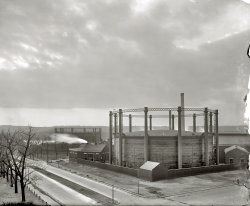
- Thanks Sherman?
- ... looks post civil war era.
Kaboom Looks to me like a gasometer exploded, judging by the twisted pieces of steel lying about, and the ...
It looks like a picture of an accident involving a gasometer - a storage structure for gas, where the cylindrical structure ... Posted by Loneliness - 09/09/2011 - 10:18pm -
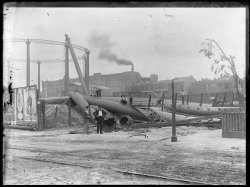
- What Goes Around: 1912
- ... identified this as the beginnings of a gas holder, or gasometer -- a storage reservoir for what used to be called "city gas," or coal ... Building a water treatment plant.
The Detroit Gasometer This looks like the foundation for a new gasometer, maybe this ... Posted by Dave - 08/09/2012 - 10:50pm -
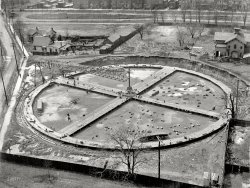
- City Gas Co.: 1913
- ... covers both sides of the overlap steel plating.
Gasometer These storage vessels were called gasometers and consisted of ... Posted by Dave - 06/18/2014 - 6:49am -
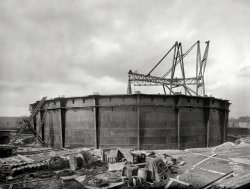
- Filling Station: 1924
- ... a pump. The pressure is measured on the gauge on the "gasometer" in the background.
Dynamometer The device is a chassis ... could be this was a demo of the device. The words on the gasometer seem to be announcing its purpose a bit too loudly for normal garage ... Posted by Dave - 08/07/2012 - 10:11pm -
![Filling Station: 1924 Washington, D.C., 1924. "Havoline Oil Company." View full size. National Photo Company Collection glass negative, Library of Congress.
Early Chassis Dynamometer? Looks like they lock down the automobile and then the drive wheels power a pump. The pressure is measured on the gauge on the "gasometer" in the background.
DynamometerThe device is a chassis dynamometer.
The dyno operator has his hand on the brake lever (Prony brake). He's either measuring horsepower and trying to relate it to engine condition or using the dyno to load the motor and collect/measure blowby somehow for the same purpose.
I wonder if this was a "special occasion" or if there was some other reason the dyno operator had so many helpers?
Mechanic Shade TreeThat's a honey locust in the foreground (note the seed pods). Memories of cleaning the pods off the driveway and yard as a kid. The tree also has huge thorns.
Special Occasion?It could be this was a demo of the device. The words on the gasometer seem to be announcing its purpose a bit too loudly for normal garage use.
Havoline Oil?The sign says Texaco, not Havoline.
[The Havoline sign is at top right. - Dave]
HavolineHavoline is Texaco's brand name for its oil and products.
(The Gallery, Cars, Trucks, Buses, D.C., Gas Stations, Natl Photo)](https://www.shorpy.com/files/images/11933u.thumbnail.jpg)
- City Gas: 1905
- ... towers. So big and matter of fact and useful! The number 8 gasometer down the road from me in King's Cross, London, is being zhuzhed up as ... Posted by Dave - 10/01/2019 - 11:14am -
![City Gas: 1905 Circa 1905. "Gas holder, Detroit City Gas Company." A familiar sight from the era of "city gas," when municipalities had their own gas plants in the days before long-distance transmission of natural gas. The telescoping sections rose or fell as "illuminating gas," which was made by heating coal, was put into or removed from the holder. 8x10 glass negative. View full size.
Gas Holder Fun FactsAs my 1911 Encyclopedia Britannica states, "A gasworks should be sited with some care as it does not improve the neighborhood." Water was kept between the telescoping sections as a seal -- the internal pressure was not that great. Cincinnati, a town which has creatively repurposed its older infrastructure, has a gasworks park with creative "sculptures" made from the old apparatus.
Oval GasGasometers are still a feature of some British city skylines, one of the most high-profile being in the background of the Oval cricket ground in South London.
WiredI am mesmerized by those wires coming in from the upper right. I suppose they run behind the container and that it's only their shadow that continues perfectly across the front until diverted by the curve - but, as I study them, they play tricks on my brain jumping from foreground to background amongst the geometric shadows.
[The wires run across the photo in front of the tank. - Dave]
So THAT's what that thing was!There was a framework that looked like this to the west of I-435 in Kansas City on the river bluffs - I wondered for years what it was. Thanks for clearing up that mystery!
Ka-BOOMGot a light.
West coast gasWhen I was growing up out here in California these things were a familiar sight in just about any city of a goodly size, even suburban San Rafael just to the north of us in Marin County. There was an enormous one in San Francisco up through the mid-1960s, at the east end of the Marina District. Here it is at the right in a section of a slide I took from across the bay near Sausalito in early 1965.
Gas Tank ParkNew York had dozens of these structures. Some of the most famous were the Elmhurst tanks. They were knocked down in the 1980s and now the site of Gas Tank Park. Near most of these structures were the gashouses which produced the illuminating gas -- sites often requiring remediation to remove the contaminant plumes of benzene and other aromatic hydrocarbons which dripped into the ground.
Got gas?Hi tterrace. That tank is now the site of the upscale Marina Safeway. However, its memory lives on in the name of the sailboat marina right across the street: Gas House Cove.
Worried ?Wonder if the people living next door ever worried about an explosion. That being said, I have never heard of one blowing up. Gas lines, yes. The neighbors most likely never had low pressure in their lines, at least.
A while back I was looking at some of these in Europe and UK online; some gas holders overseas have been converted to condominiums or apartment buildings!
"Gasometers"I live in London, and you will still see these structures all over England and particularly in the large cities. We call them "Gasometers," and they are still part of the national grid for gas distribution.
Love em in London!These things seem to inspire the same fond feelings as water towers. So big and matter of fact and useful! The number 8 gasometer down the road from me in King's Cross, London, is being zhuzhed up as part of the regeneration of the area. Hopefully they'll keep it a little bit weird and rusty.
http://www.bp-k.com/projects/Gasholder.html
An Illuminating Subject.When I was young, not far from our home was a coking plant which had two huge gas holders of the type shown.
They would slowly rise as gas was produced and fall as gas consumption exceeded supply.
The adjacent gas works would emit an atomic cloud of steam as a coke oven was "pushed" and the glowing coke quenched by water before it was loaded into steel hopper cars.
On occasion a wood-sided hopper was used, the coke not completely quenched, and the resulting fire caused by the wind of the train's motion would burn thru the car side and a glowing lava of coke pour out as the train moved down the track.
Steel coke cars would sometimes glow in patches at night.
I do not know if there are any gas holders of this design left.
I would like to ride on top of one and watch it inch up by looking at the framework, and see it pause as the pressure inside had to increase to lift the next section.
I tell younger people about them and they do not grasp the idea of the telescoping sections at all, how the pressure inside, although low, was enough to lift the tons of metal the tanks sections were made of.
Other gas holders were circular and made with bricks, not rising nor falling.
The whole coke plant and the gas holders are long gone, ugly to be sure, being replaced with even UGLIER slumplexes of high-density housing.
LandmarksThose Elmurst, NY, Gas Tanks were a staple for many Long Island Expressway Commuters. Traffic reporters would announce, with almost every daily (weekday) morning drive heading to The Queens-Midtown Tunnel, that the major tie-ups would be in the vicinity of the gas tanks. Incidentally, the tanks themselves rose and fell according the volume of gas in them.
They could have preserved itby turning it into a park, like we did here in Seattle.
Same in St. LouisThere was at least one of these on highway 64/40 in St. Louis that I used to pass daily on my commute. It would rise and fall and I always wondered what it was. I'd heard it was for natural gas but I never really understood, but now I do. Great photo- thanks for posting!
http://www.builtstlouis.net/industrial/gasometers.html
Roll up the windows! We passed two of these tanks en route to Grand-ma's Brownstone in Brooklyn, NY. But the associated cracking plants and their gas flare towers sent the pervasive stench of rotten eggs drifting over the county for miles around. We all held our noses and made rude noises until shushed by the adults.
Wow, popular topic! I just wanted to add that modern tanks act as flow buffers, just like water towers. Instead of just storing locally made gas, they store a 'back-up' quantity of product to handle periods of high demand, but are fed by massive pipelines from distant plants.
(The Gallery, Detroit Photos, DPC)](https://www.shorpy.com/files/images/4a20632a.thumbnail.jpg)
- White Flash: 1943
- ... the hood.
Gasoline and Gas Another great view of a gasometer right behind them. Would not want to be there if that thing blew up! ... Posted by Dave - 09/30/2013 - 5:59pm -
![White Flash: 1943 June 1943. "Philadelphia, Pennsylvania. Women garage attendants at the Atlantic Refining Company." The hard part here was figuring out that crazy clamshell hood. Photo by Jack Delano for the Office of War Information. View full size.
It looks like aLaSalle.
[Not even close. - Dave]
I think it's a1942 Dodge.
[Correct! -Dave]
West Philly GasI would suggest the image is taken from the southwest corner of Chestnut Street at Markoe Street (now called Farragut St)in West Philadelphia, looking towards the large natural gas storage tank at 47th and Chestnut. The gas tank is gone, but a BP station remains where these ladies were checkin' under the hood.
Gasoline and GasAnother great view of a gasometer right behind them. Would not want to be there if that thing blew up!
Full ServiceI remember full service back in the day when the attendant would check your oil, clean your windshield and maybe even check your tire pressure. But the young lady with the whisk broom? What's she going to do, sweep out the interior? That's really full service.
Rethinking West Philly "Gas"The gas stored in containers like these would be of the manufactured variety-- a by-product of a coal carbonization process that yielded a gas that was both toxic and heavier than air at atmospheric densities. In those days, manufactured gas consumers could and did asphyxiate themselves by simply turning on an unlit stove burner in their home. It was the toxic constituents in the gas that did them in. Save for legacy manufacturing sites subject to environmental remediation, manufactured gas has been almost totally supplanted by natural gas as piped to customers through distribution utilities. "Natural gas" as we consumers know it today comes out of the ground, is delivered through interstate pipelines, and is odorless until the mercaptan odorant is added for safety.
Dress Shoes?Looks like the ladies are wearing loafers (without socks, too). I guess workplace regulations at that time did not require steel toe work boots. My mechanic says he would never work without them; he's lost track of how many times he's dropped something on his foot....
PantsLove the cargo pants part of the coveralls ... although the cuffs need work.
Last Call for CarsThis would be one of only 22,055 Dodge Custom four-door sedans built in that war-shortened year (more may have been made for government use), but I'm sure it had Fluid Drive to absorb some of its 101 horsepower from a slightly enlarged flathead six.
There was an even rarer (13,000 built) example of the less expensive DeLuxe sedans with the blacked out trim here in town as late as the 70's and I've always wished I'd bought it!
Lost inspirationIf the writers of the "I Love Lucy" show back in the early fifties had seen this photo, there would probably have been a classic episode of Ethel Mertz and Lucy working at an auto service center. Oh well, you can always write your own.
Bumper JackIf you enlarge the photo and look just left of the left knee of the lady on the right, you can see the reflection of the photographer, Jack Delano, in the shiny car bumper as he is taking the photo.
That CornerHistoricAerials.com still shows those billboards on top of the Buick dealer on the northeast corner of 47th & Chestnut streets in 1950. The gasholder is on the northwest corner.
(The Gallery, Cars, Trucks, Buses, Gas Stations, Jack Delano, Philadelphia)](https://www.shorpy.com/files/images/SHORPY_8d31098a.thumbnail.jpg)
- Detroit Rubber Works: 1908
- ... smoke stacks.
Cookin' With Gas Great view of a gasometer complete with promotional message on it.
Story in dBusiness ... Posted by Dave - 07/29/2012 - 6:16pm -
![Detroit Rubber Works: 1908 Detroit, Michigan, 1908. "Detroit Rubber Works." 8x10 inch dry plate glass negative, Detroit Publishing Company. View full size.
What do they manufacture? Vulcanized, galoshes and boots, rubber bands, or condoms?
[Hmm. Detroit? Rubber? Morgan & Wright was the world's largest maker of bicycle tires when, in 1906, they moved from Chicago to Detroit to exploit the needs of the growing automobile industry. In 1911 the company was sold to the U.S. Rubber Co., renamed Uniroyal in 1961.]
I found the steam whistle!Just to the left of the two "smoking" smoke stacks.
Cookin' With GasGreat view of a gasometer complete with promotional message on it.
Story in dBusiness Magazine this MonthI just read a story about them/Uniroyal in the Jan/Feb 2012 issue of dBusiness magazine (a Detroit business periodical).
Morgan & Wright's Wartime WomenDuring World War I, Morgan & Wright hired many women to fill essential production jobs previously held by men. Here's a photo from the collection of Wayne State University. Amelia Bloomer and Parisian fashion designers usually get the credit for introducing women to wearing trousers, but it's likely that more American women got to experience this for the first time during their temporary wartime jobs.
Strange PhotoIt looks like something painted by Edward Hopper.
Not even a rubber band can be found there today.[Area immediately southwest of MacArthur Bridge Park.]
View Larger Map
What did they make?Bet they made some Baby Buggy Bumpers.
Uni, Roy & AlUni, Roy & Al say "Cook with Gas".
(The Gallery, Detroit Photos, DPC, Factories)](https://www.shorpy.com/files/images/SHORPY_4a22549a.thumbnail.jpg)
- Winter Wonderland: 1941
- ... and was reinforced one day when we happened to drive by a gasometer and men were sitting on the top. They were probably painting the ... we happened to catch them on a break.
Finally! A gasometer in living color!
Bleak and bleaker This photo probably looks ... Posted by Dave - 05/31/2018 - 10:40am -
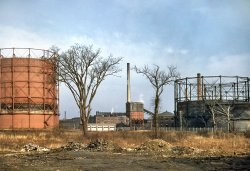
- I at First: 1901
- ... -- I Street at First Street S.W." Note the gas holder, or gasometer, at right; and black bunting or mourning crepe under the rowhouse ... Posted by Dave - 02/01/2021 - 12:51pm -
![I at First: 1901 Washington, D.C., 1901. "Elevated view looking southeast from Randall Elementary School -- I Street at First Street S.W." Note the gas holder, or gasometer, at right; and black bunting or mourning crepe under the rowhouse windows, possibly in the aftermath of President McKinley's assassination. 8x10 glass negative, D.C. Street Survey Collection. View full size.
Tall open structure on far leftAnyone have an idea what that could be? It looks like a 'house on stilts' and is probably relatively modern, as that could be metal rather than wood posts. I see a smokestack as part of the structure (and that makes me wonder what they're using for fuel, possibly natural gas?)
[There was no natural gas in D.C. back then. The gas used for fuel at the time was coal gas, a.k.a. illuminating gas or "city gas." - Dave]
Whose at Second?Someone was going to say it!
[Whose what? - Dave]
No! What's at third. Who's at second!
OleaginousTo answer the question posed by TheGerman, the Nicolai Brothers are listed in the 1901 city directory under "Oil dealers" alongside Standard Oil. Draw your own conclusions.
Privy to Your Secret GardenI recall reading years ago a book titled "Washington Goes To War" written by the very talented newsman David Brinkley. In it, he described D.C. at the start of WWII as a very Southern city with many thousands of outdoor privies still in use. Plenty here in 1901, which must have made that back alley splendiferous on a hot summer day.
In the distanceThe church at left in the background is St. Matthew’s Chapel. A check of the 1903 Baist atlas doesn’t provide any clues (to me, anyway) about the nature of the “penthouse on stilts” just north (and east?) of it, also on M Street SE.
Three units of inquiryOne: Were the brick tenements built so that each unit had two fireplaces (hence two chimneys apiece), or were there two residential units per long narrow section (a front and a back), with one fireplace apiece? I'm inclined to believe it's the former but I'd like to know what other Shorpy sharp-eyes think.
Two: There is something standing in the field about midway down the long line of youngish trees. It looks like a horse with its head down, grazing. Do my eyes deceive me, or is it indeed an equine unit with the munchies?
Three: Beneath the far-right upstairs window of the brick tenement to the left of the wooden apartment building is what looks like an air conditioning unit. But since those weren't invented until thirty years later (I looked it up), what could it be?
Anyone?
Not an AC UnitThat is a window planter box and those are most likely cows grazing in the fields.
If you wanted fresh milk in 1901 it was best to have a cow nearby.
Looking at these photos always make me feel as if I was living there at that time. It looks so familiar.
[That biscuit crate under the window is nature's refrigerator. The animal in the vacant lot at the center of the frame is indeed a horse. If you wanted fresh milk, Washington was well supplied with dairies. - Dave]
Re: Three units of inquiryOne: My best guess is that there are two fireplaces, one at ground level and one at the first floor. Note that one of the chimneys is not like all the others, there is one much larger chimney to the left of the gas holder at the left end of the building. I wonder what that is for??
Two: Could be, but my eyesight isn't what it used to be.
Three: This might be a wooden(?) crate to store milk bottles or food/liquids that require cooler temperatures rather than an AC unit. We are looking to the southeast so this side of the building doesn't get much sunshine in the winter.
What I would like to know is what kind of oils the Nicolai Brothers are selling??? Is that oil used for heating, oil (of various density) to lubricate small and large machines or oil meant for human consumption (cooking oil etc.)??
[Nicolai Bros. supplied the District with naphtha fuel for street lighting. This liquid hydrocarbon was a byproduct of coal gasification. - Dave]
Re third questionIf my dad were around, he would tell you that it might be an "ice" box. In college in Virginia (pre-WWII), he had one outside his third story dorm room window. He and his roommate built it to keep their sloe gin, beer, and other necessities nice and cool. Worked well in cooler and winter months, not so well in warmer or summer months.
(The Gallery, D.C., D.C. Street Survey)](https://www.shorpy.com/files/images/SHORPY-DCSS-40416a.thumbnail.jpg)
- Moving Day: 1938
- ... up! As a young boy, my father and I drove past a gasometer. There were several men sitting on top of the bladder with their legs ... Posted by Dave - 10/07/2018 - 10:10am -
![Moving Day: 1938 New York, 1938. "East 62nd Street." Medium format acetate negative by Sheldon Dick for the Farm Security Administration. View full size.
Right There in ManhattanI spy some great gasometers lurking in the distance.
The 2 Round Towers Does anybody know what those two, apparently round, structures are there were being built at the end of E. 63rd down by the water?
I've tried finding out online but to no avail.
[Those are gas holders, also known as gasometers, and they're not under construction. - Dave]
Those trousers!Can anyone share any insight into that pair of pants? Was that a style? Born of necessity? Please advise.
There's a lot of fabric in those pantsWas this style popular circa 1938?
East 62nd, not 63rdBetween Second and First avenue as this 1930 Plat map of Manhattan shows the Bristol company on 62nd Street.
http://www.historicmapworks.com/Map/US/16723/Plate+105/Manhattan+1930+La...
Split apronThe mover appears to be wearing a split apron similar to a farrier's apron. It allows you to bear loads on the front of your thighs while protecting your trousers and your skin from punctures and abrasion.
Not Pants?I can remember trashmen in Philadelphia in the mid 1950s wearing that kind of heavy cloth leg apron that didn't go above the waist. I think a trashman character in the Snuffy Smith comic strip also wore it.
Fill 'er up!As a young boy, my father and I drove past a gasometer. There were several men sitting on top of the bladder with their legs hanging over the side. My father said they were filling it up. It's easy to fool a kid when he adores his father.
Rubber NeckersI know there have been other photos showing people watching life go by from their windows, but this is one of the few I remember. I've always thought it odd that more people didn't keep an eye on that stranger in the 'hood with a camera.
Wonder WomanI wonder what the woman on top of that building was doing - aside from making me nervous -- 80 years later.
[This might be a good opportunity to investigate the difference between "woman" and "women." - Dave]
Ahhh... isn't it great when it's never too late to learn singular from plural?!
Heavens to BetsyI hope she isn't going to jump!
Still there (mostly)Looking at Google Maps Street View, the building that housed The Bristol Co. at 319 E. 62nd Street is still there, as is the building across the street at 316 (although one half of the parapet has strangely disappeared):
(The Gallery, Cars, Trucks, Buses, NYC, Sheldon Dick)](https://www.shorpy.com/files/images/SHORPY-8c35313a.thumbnail.jpg)
- Gas Giant: 1937
- ... ("taking the gas pipe"). The tank-like structure, called a gasometer or gas holder, telescoped up and down depending on how much gas was ... Posted by Dave - 06/14/2017 - 3:32pm -
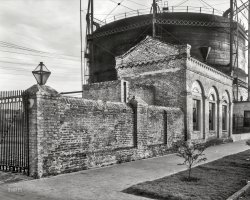
- Use a Vapor Stove: 1901
- ... the far distance to the left of the flagpole, we see the gasometer at 12th & M SE, which put in a cameo appearance on Shorpy ... Posted by Dave - 02/02/2021 - 2:30pm -
![Use a Vapor Stove: 1901 Washington, D.C., circa 1901. "An elevated view from the Randall School's roof looking east to southeast -- Half & South Capitol Streets, and I & K Streets." Our title can be found on the left side of this 8x10 glass plate negative from the D.C. Street Survey Collection. View full size.
GlimpsesAt center left, we can see the stone-reinforced east bank of the James Creek Canal. According to a 1977 Interior Department report, "citizens fell into the unfenced waterway at an astounding rate, sometimes resulting in as many as one drowning per month." Eventually, the foul-smelling canal was converted into an underground sewer.
In the far distance to the left of the flagpole, we see the gasometer at 12th & M SE, which put in a cameo appearance on Shorpy some years back.
Ghosts Do you suppose the exposure was long enough that the person sitting down, and his ghostly friends, are the same people at the end of the street?
SmokestacksTil I looked at the Full Size version I assumed the plant (in front of the Stove Store) was running and the stack had an exhaust plume. Then I realized the smoke is a remnant on the negative.
[It is not a "remnant" (and the proper term would be "artifact"). - Dave]
No, thank you.I'll pass on the vapor stove. I have a hard enough time filling the lawn mower tank.
(The Gallery, D.C., D.C. Street Survey, Kids)](https://www.shorpy.com/files/images/SHORPY-40419a.thumbnail.jpg)
- Rollersnake: 1922
- ... delicti The view here is toward the southeast. Note gasometer in the distance (at 12th/M gasworks); intersection of 10th & L SE ... Posted by Dave - 09/06/2016 - 2:17pm -
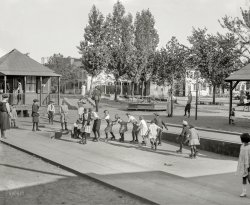
- N.Y. Linen: 1938
- ... of New York Linen Supply, seen here earlier , and a gasometer, or gas holder, from the era of "city gas." Acetate negative by ... Posted by Dave - 09/30/2019 - 5:58pm -
![N.Y. Linen: 1938 1938. "New York, New York. A scene on East 62nd Street." Showing the vans of New York Linen Supply, seen here earlier, and a gasometer, or gas holder, from the era of "city gas." Acetate negative by Sheldon Dick for the Farm Security Administration. View full size.
Scene from The GodfatherAny minute, I expect to see Sonny Corleone jump out of a car and start beating his brother-in-law Carlo with a trash can lid!
The end of the streetSo that's what the thing at the street is ... a gas tank? At first I thought it was something under construction because I couldn't tell if that was scaffolding or trussing surrounding it.
[It's a telescoping gas holder. - Dave]
(The Gallery, NYC, Sheldon Dick)](https://www.shorpy.com/files/images/SHORPY-8c02060a.thumbnail.jpg)
- SF Waterfront, 1957
- ...
By the way, the gas tank is more properly called a 'gasometer' and is used for storage of coal gas/coke gas/natural gas -- not ... Posted by Rute Boye - 08/10/2012 - 7:59pm -
![SF Waterfront, 1957 Another in the San Francisco series taken by my father, this time of the waterfront, not far from Fisherman's Wharf. A few things of interest here:
- The Chinese junk in the foreground
- Coit Tower in the background
- The steel frame for a gas pressure equalization tank on the right
- The sailing ship "Balclutha", just behind the junk.
View full size.
Further interestThere's a nice green 1954 Caddy there, too.
By the way, the gas tank is more properly called a 'gasometer' and is used for storage of coal gas/coke gas/natural gas -- not pressure equalization. Its telescoping steel cylinders are raised or lowered by electric motors depending upon how much volume is required to hold the gas inventory.
The vantage point from which this photo was made seems to be gone now. Google shows the arched gate without any pier extending out from it.
Earlier than 541954 Caddies had the Panoramic windshield I believe. Thinking this one might be a 52 or 53. One of my favorite models of all time.
[It's a 1952. In 1953, "Dagmar" bumper guards replaced the round parking lights. The Panoramic windshield first appeared in 1953, but only on the Eldorado. - tterrace]
Chinese JunkThe vessel pictured here is the "Free China". It is of the type from Fujian (Fukien) province, and was sailed over from Formosa in 1955 by five Chinese and an American Vice consul who filmed the voyage in 16mm.
In the early 70s I lived on a small Chinese Junk in the bay, and I used to visit this boat down in the Hunter's Point area. It was quite derelict by then. It has apparently been loaded on a barge (after spending years behind Bethel Island), and shipped back to Taiwan to be turned into a museum.
(ShorpyBlog, Member Gallery)](https://www.shorpy.com/files/images/SFPiers1957_0.thumbnail.jpg)























